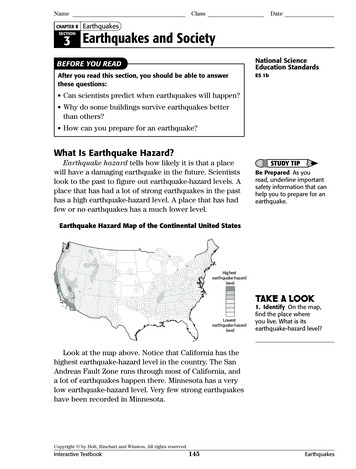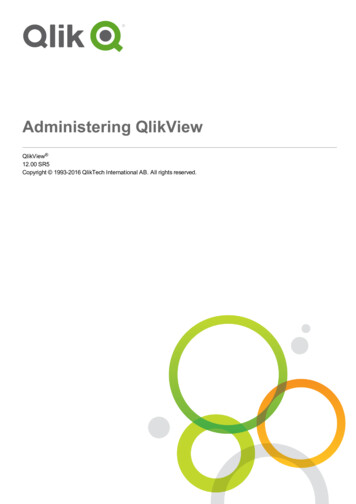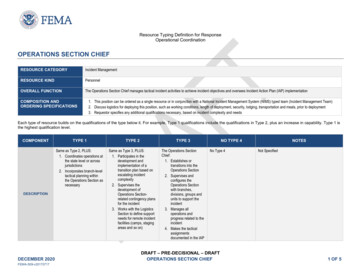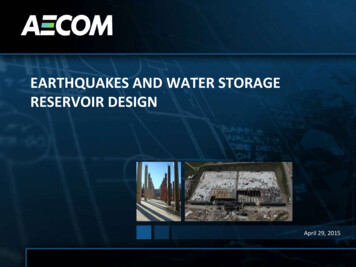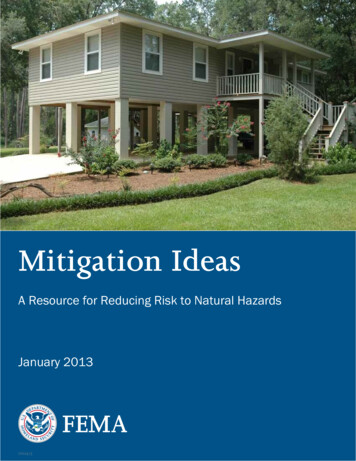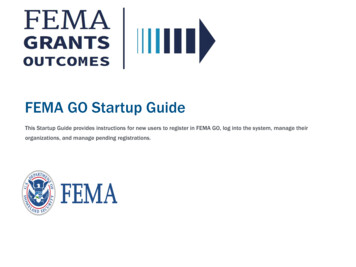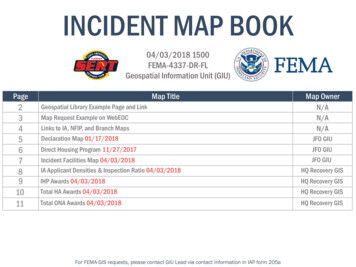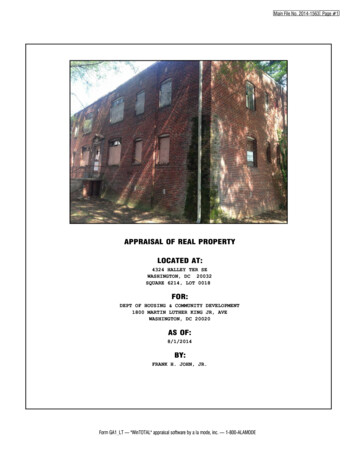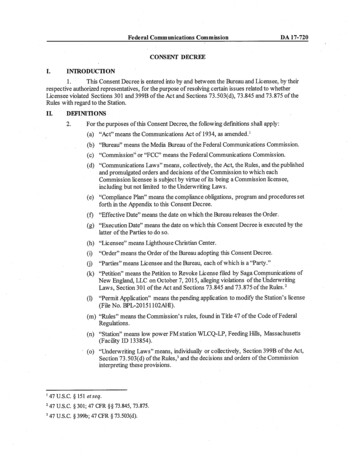
Transcription
EARTHQUAKESA Teacher’s Package for K–6EARTHQUAKES-FEMA 159 1
AcknowledgmentsThe Federal Emergency Management Agency (FEMA) acknowledges with gratitude themany individuals who provided teaching knowledge, experience, and classrooms in thedevelopment of the first and revised versions of EARTHQUAKES - A Teacher’s Packagefor K-6 Grades.The first version of the teacher’s package was developed under the direction ofPhyllis R. Marcussio, Director of Publications, National Science Teachers Association.Ms. Marcussio put together an excellent team of editor, illustrator, teacher-writers,subject-matter experts, and reviewers, including —Editor:Mary Liston Liepold, Washington, DCIllustrator:Forrest Plesko, Superior, WITeacher-Writers:Jeffrey C. Callister, Newburgh, NYLenny Coplestone, Bethesda, MDGerard F. Consuegra, Rockville, MDSharon M. Stroud, Colorado Springs, COScientist-Writer:Randy Updike, U.S. Geological SurveyThe revised version included teacher-writers Jeffrey Callister, Gerard Consuegra, andSharon Stroud, along with Elizabeth Draper, Sheryl Eggers, and Molly Morrow fromPortland, OR. Elizabeth, Sheryl, and Molly have participated as instructors in numerous FEMA workshops for educators on the K-6 teacher’s package. Randy Updike’sexpanded coverage of earthquake topics remains in the Appendix.Funding for this publication was allocated to FEMA by The United States Congress,under the Earthquake Hazards Reduction Act of 1977, as amended. FEMA herebyauthorizes and encourages the educational community to reproduce this product inits entirety and to disseminate it at no cost to the recipient.Single copies of this publication may be obtained from FEMA at no cost by contactingFEMA’s Publication Warehouse at 1-800-480-2520.2 EARTHQUAKES-FEMA 159
Foreword to the Second EditionThe original Earthquakes - A Teacher’s Package for K-6(FEMA 159) was developed as a joint effort of theFederal Emergency Management Agency (FEMA) andthe National Science Teachers Association (NSTA)under contract with FEMA. NSTA’s project team produced an excellent product. Since its publication in1988, over 50,000 teachers have requested copies.This revised version brought members of the originalproject team together with a group of teachers who hadused the materials extensively in their classroom andserved as teacher-educators at FEMA’s Tremor Troopworkshops. About 75% of the original materialremains unchanged: a few activities were removedand a few added.A major change was the addition of assessmentsthroughout the units. The examples we provide relateto life outside the classroom and/or activities similarto those of scientists. We also added matrices linkingactivities to the National Science Education Standards.You’ll find these matrices in the Appendix, along witha new Glossary.EARTHQUAKES-FEMA 159 3
Features of This PackageFirst of all, you do not need an education in science touse this package. Background for each unit covers allthe science concepts treated in the lessons. You willhave all the information you need, no matter whatgrade you teach and what kind of science preparationyou’ve had. This is science made simple and fun,without sacrificing scientific accuracy.Because young students learn best by doing, thelessons in this teaching package are primarily a seriesof hands-on experiences. You will need to locate simplematerials for some of the lessons. Others require onlythings that are already in your classroom. At the endof each unit, you will find Masters ready to reproducefor transparencies, handouts, and worksheets. Mastersare identified in the text by name and number.Because students learn holistically, the lessons include methods and materials from language arts,mathematics, social studies, music, and the other finearts, as well as physical science. Learning Links, foundnear the beginning of each set of activities, summarizesome of these interdisciplinary connections. We alsoprovided Scope and Sequence charts at the beginningof each unit.Extensions, provided in each set of activities, suggestways for your students to learn more about the topics.Use the Extensions for individual enrichment or toprovide additional experiences for the entire class.Each set of activities also includes vocabulary, teaching tips, and illustrations. Matrices linking activities tothe National Science Education Standards are locatedin the Appendix.4 EARTHQUAKES-FEMA 159
Organization and OverviewThe Teacher’s Package has five units. Each of the firstfour units is divided into three levels: Level 1, forgrades K-2; Level 2, for grades 3-4; and Level 3, forgrades 5-6. Since classes and individuals vary widelyyou may often find the procedures in the other levelshelpful for your students. The last unit has four partswith activities for students in all grades, K-6.Unit I, Defining an Earthquake, builds on whatstudents already know about earthquakes to establisha working definition of the phenomenon. Legends fromnear and far encourage children to create their ownfanciful explanations, paving the way for the scientificexplanations they will begin to learn in this unit.Unit II, Why and Where Earthquakes Occur, presents the modern scientific understanding of theEarth’s structure and composition, and relates this tothe cause of earthquakes.Unit III, Physical Results of Earthquakes, providesgreater understanding of the processes that shape ouractive Earth. Earthquakes are put in the context of thelarge- and small-scale changes that are constantly atwork on the continents as well as the ocean floor.Unit IV, Measuring Earthquakes, explains earthquakes in terms of wave movement and introducesstudents to the far-ranging effects of earthquakes.Unit V, Earthquake Safety and Survival, focuses onwhat to expect during an earthquake; how to copesafely; how to identify earthquake hazards; and how toreduce, eliminate, or avoid them.Units I through V are intended to be used in the orderpresented. When students ask questions about earthquake safety, the introduction in Unit V will help youanswer their questions. You may want to take timethen to do a few activities to enable students to developquake-safe skills.EARTHQUAKES-FEMA 159 5
ContentsUnit I: Defining an EarthquakeLevel 1. What Is an Earthquake.13Level 2. People Explain Earthquakes.19Level 3. Energy Waves Cause Earthquakes. 25Unit II: Why and Where Earthquakes OccurLevel 1. Inside Planet Earth. 39Level 2. Plates Going Places.43Level 3. Layers, Plates, and Quakes.51Unit III: Physical Results of EarthquakesLevel 1. Earthquakes Shape Our Earth.65Level 2. Landscape on the Loose.69Level 3. Building Up and Breaking Down.79Unit IV: Measuring EarthquakesLevel 1. Earthquakes Great and Small.93Level 2. Different Shakes for Different Quakes.99Level 3. Sizing Up Earthquake Waves.103Unit V: Earthquake Safety and SurvivalPart 1. What Happens During an Earthquake.117Part 2. Hunt for Hazards. 125Part 3. Prepare and Share. 133Part 4. Evacuation Drill. 139AppendixEarthquake BackgroundBook of LegendsNational Science Education Standards MatricesGlossary6 EARTHQUAKES-FEMA 159
Earthquake Curriculum,K-6 List of Line MastersUNIT .10a.10b.11.UNIT IIMaster 12a.Master 12b.Master 13.Master 14a.Master 14b.Master 15.Master 16.Master 17.Master d.UNIT IIIMaster 21.Master a.24b.25a.25b.25c.26.U.S. Map (without state names)U.S. MapThe Turtle TaleTurtle Tale Pop-up PuppetTurtle Dot-to-DotWorld MapWorld Map with Legend SitesWorld Map with EpicentersElastic ReboundDresser DrawersEarthquake TermsEarthquake Terms WorksheetU.S. Map with EpicentersLayers of the EarthEarth Layers WorksheetEarth PlatesEarth Plate Puzzle PiecesEarth Plate Puzzle PiecesA Pizza the EarthGraph of the Earths LayersPlate Boundaries MapConvection Currents andPlate Cross SectionFormation and Breakup of PangaeaPangaea Flip BookPangaea Flip BookPangaea Flip BookPangaea Flip BookUNIT IVMaster 27.Master 28.Master 29.Master 30.Master 31.Master 32.Master 33.Master 34.Master 35.Master 36a.Master 36b.Master 36c.Shake TableModified Mercalli ScaleSeismographsSeismogram WorksheetEarthquake Magnitude and EnergySeismogram Showing AmplitudeEarthquake Severity WorksheetP-Wave Motion and S-Wave MotionThe S-Wave MachineKWAT Television ScriptWattsville MapWattsville Map KeyUNIT VMaster 37.Master 38.Master 39.Master 40.Master 41.Master 42.Master 43a.Master 43b.Master 43c.Master 44.Master 45.Master 46.Master 47a.Master 47b.Master 47c.Master 48.Master 49.Earthquake Hazard of the U.S.Earthquake Simulation ScriptDrop, Cover and HoldCoalinga Schools ReportFourth Grade ClassroomClassroom Hazard HuntHome Hazard Hunt WorksheetHome Hazard Hunt WorksheetHome Hazard Hunt WorksheetQuake-Safe Home ChecklistNeighborhood Hazard HuntSafety Rules for ShoppersCommunity Hazard HuntCommunity Hazard HuntCommunity Hazard HuntDrill and Evacuation ChecklistHome Earthquake SafetyFault MovementsRural Community After anEarthquakeFault ModelTsunami FactsNotable TsunamiLandscape Regions WorksheetLandscape Regions of U.S.Landscape Regions KeyOcean BottomEARTHQUAKES-FEMA 159 7
8 EARTHQUAKES-FEMA 159
IDefining an Earthquake
Earthquake Curriculum, K–6 -- Scope and Sequence ChartUnit I: Defining an EarthquakeLevelConceptLaboratoryK–2An earthquake is a sudden,rapid shaking of the Earthcaused by the release ofenergy stored in rocks.Sand and boxdemonstration ofearthquakesMathematicsLegends are traditionalnarrative explanations ofnatural phenomena thatevolve when scientific explanations are not available.3–4An earthquake is a sudden,rapid shaking of the Earthcaused by the release ofenergy stored in rocks.Language ArtsSocial StudiesArtVocabulary development of earthquakewordsEffects of earthquakes on modelbuildingsIllustrations oflegendsOriginal earthquakelegendsEffect of earthquakes on peopleIllustrations ofEarth’s interiorMural makingCultures and legendoriginsSilicone putty rocksEarthquake legendsGelatin simulation ofearthquakesParagraph writingClass discussionLegends are traditionalnarrative explanations ofnatural phenomena whichevolve, when scientificexplanations are not available.Map study ofcultures associatedwith earthquakelegendsMap study ofepicentersIllustrations ofearthquake causesIllustrations ofearthquakelegendsEarthquake energy is releasedin the form of waves.5–6Earthquakes result from thebuild-up and release of energystored in rocks.Earthquakes occur over muchof the world and the UnitedStates.Various societies have produced earthquake legends toexplain these natural occurrences.Stick simulation ofearthquakesFault action gameMap scales tomeasure distancesVocabulary development of earthquakewordsEarthquake legendsOral reading andnote takingMap study ofearthquake locationsMap study ofcultures associatedwith earthquakelegendsMap study of statelocationsSign makingDiagram making
IDefining an EarthquakeAn earthquake is a natural phenomenon like rain.Earthquakes have occurred for billions of years. Descriptions as old as recorded history show the significanteffects they have had on people’s lives. Long before therewere scientific theories for the cause of earthquakes,people around the world created folklore to explainthem. In simple terms, earthquakes are caused by theconstant motion of Earth’s surface. This motion createsbuildup and releases energy stored in rocks at and nearthe Earth’s surface. Earthquakes are the sudden, rapidshaking of the Earth as this energy is released.At half-past two o’clock of a moonlit morning inMarch, I was awakened by a tremendous earthquake, and though I had never before enjoyed astorm of this sort, the strange, thrilling motion couldnot be mistaken . . . Both glad and frightened, [Ishouted]: “A noble earthquake! A noble earthquake!”feeling sure that I was going to learn something.John Muir, 1872EARTHQUAKES-FEMA 159 9
IDefining an EarthquakeDefining an EarthquakeAn earthquake is a natural occurrence, like rain.Earthquakes affect almost every part of the Earthand like rain they can be either mild or catastrophic.Over the course of geological time, earthquakes,floods, and other natural events have helped toshape the surface of our planet.An earthquake may last only a few seconds, but theprocesses that cause earthquakes have operatedwithin the Earth for millions and millions of years.Until very recently, the cause of earthquakes was anunsolved mystery. It was the subject of fancifulfolklore and equally fanciful learned speculation bypeoples throughout the world.In a legend from Siberian Kamchatka, a god named Tuli drives anEarth-laden sled pulled by flea-infested dogs. When the dogs stop toscratch, the Earth shakes.***Some say the Earth was fevrous [feverish] and did shake.Shakespeare, Macbeth, IIIIn the mid-1960s, many scientific observations andexplanations of earthquakes came together in thetheory of plate tectonics. We’ll be exploring thatsubject in later units. In this unit we consider bothscientific and popular explanations for the phenomenon and look at the patterns of earthquake occurrence worldwide.An Earthquake Is . . .An earthquake is a sudden, rapid shaking of theEarth caused by the release of energy stored inrocks. This is a brief definition which students of allages can master. A full definition of the term, however, would need to include a good deal moreinformation.Students may be surprised that we speak of rocksand rock layers, because in many places the rockmaterial of the Earth’s crust is covered by accumulations of sand or soil. Remind them that even beneaththe sediment in river valleys, plains, and beachareas, some kind of rock is always present.10 EARTHQUAKES-FEMA 159
Defining an EarthquakeIEarthquake shaking may cause loss of life and destruction of property. In a strong earthquake theground shakes violently. Buildings may fall or sinkinto the soil. Rocks and soil may move downhill at arapid rate. Such landslides can bury houses andpeople.Folklore and Scientific TheoryPressure DirectionDeformed RocksFaultEarthquake WavesBecause strong earthquakes have such disastrouseffects, it is not surprising that people have alwayslooked for ways to explain their origin. We find manynonscientific explanations of earthquakes in thefolklore of civilizations around the world. We callthese traditional narratives earthquake legends.Some of them are still being told today.What we have learned in recent years, however,largely from the study of earthquakes, is that theEarth around us is not static, like a stage set for aplay. The Earth’s rock layer is broken into largepieces. These pieces are in slow but constant motion.They may slide by smoothly and almost imperceptibly.From time to time, the pieces may lock together, andenergy that accumulates between the pieces may besuddenly released. This sudden release of energy,like the snapping of a rubber band that has beenstretched too far, is what we call elastic rebound.Energy is released and travels through the Earth inthe form of waves. People on the surface of the Earthexperience an earthquake.FaultEpicenterFocusEarthquake WavesEARTHQUAKES-FEMA 159 11
IDefining an EarthquakeEarthquake EpicentersThe epicenter of an earthquake is the place on theEarth’s surface directly above the focus (or hypocenter),the place inside the Earth where the quake originates.Earthquake foci are usually somewhere between thesurface and 100 km in depth. In some areas, however,foci may be as deep as 700 km.Even a glance at an earthquake epicenter map showsthat most earthquakes have occurred in certain welldefined regions of the Earth. Because these regionstend to be relatively long and narrow, they are sometimes referred to as earthquake belts.One large belt of epicenters runs through the Mediterranean Sea, Asia Minor, the Himalayan mountains,and into the eastern Indian Ocean. A second large beltruns northward through the western Pacific Ocean, theJapanese islands, the Aleutian islands, and the westcoasts of North and South America. The longest belt ofearthquake epicenters runs through the central regionsof most ocean basins. The world epicenter map alsoshows some shorter belts of epicenters.Chances are, even if your school is far from any earthquake epicenter, your students already have someideas about earthquakes and what causes them. In thelessons that follow, you will invite them to tell you whatthey think.Master 7, World Map with Epicenters. The dots represent earthquakes with magnitudes 5.0 recorded from 1980-1990 by theNational Earthquake Information Center, USGS.12 EARTHQUAKES-FEMA 159
Defining an Earthquake/ Unit I, Level 1, Grades K-2IWhat Is an Earthquake?Content Concepts1. An earthquake is a sudden, rapid shaking of the Earthcaused by the release of energy stored in rocks.2. Legends are traditional narrative explanations of natural phenomena that evolve when scientific explanationsare not dents will—describe personal experiences with earthquakes.—construct an earthquake model.—observe effects of a simulated earthquake.—define the term legend, and listen to a legend.—suggest possible causes of earthquakes.—write and illustrate original legends.—draw pictures to illustrate their ideas about the Earth’sinterior.AssessmentRestate The Turtle Tale. Draw or tell three imaginative,non-scientific explanations for Earth movement.Learning LinksLanguage Arts: Writing a descriptionof a demonstration (older students),sharing ideas about the possible causes ofearthquakes, building vocabulary, listeningto a legend, creating an original legendArt: Illustrating the legends, expressingideas about the Earth’s interior in drawing,contributing to a muralSocial Studies: Observing the effectsof a simulated earthquake on modelbuildings, predicting the effects onpeople’s lives, discussing a NativeAmerican legend, locating San Gabrielon a U.S. mapEARTHQUAKES-FEMA 159 13
IDefining an Earthquake/ Unit I, Level 1, Grades K-2Activity One: Tremble Here, Tremble ThereMaterials for the teacher A small table or desk that moves easilyMaterials for each small group of students A shallow box partially filled with sand or soil An assortment of paper plates, cups, and small boxes thatcan be stacked to represent a building.Procedure1. Introduce the topic with a class discussion based on thefollowing questions:What does the word quake mean?What do we mean when we say people are “quaking intheir boots”? (Invite students to imitate a persontrembling.)Have you ever been on a bridge when it shook from heavytraffic, or near the railroad tracks when a train passedover? (Invite students to demonstrate shaking and vibrating.) What do you suppose is happening to the Earthwhen there is an earthquake?Has anyone here ever felt an earthquake? (Allow studentstime to express their observations and feelings.)14 EARTHQUAKES-FEMA 159earth quakeAn earthquake is a sudden, rapidshaking of the Earth caused by therelease of energy stored in rocks.leg endsLegends are traditional narrativeexplanations of natural phenomenathat evolve when scientific explanations are not available.
Defining an Earthquake/ Unit I, Level 1, Grades K-2I2. Tell students they are going to make a model to demonstrate what happens during an earthquake. Follow thesesteps:a. Invite a small group of students to pile plates, cups,and small boxes on top of each other in thefilled box to form a tall structure. (Either haveenough materials for each group to constructone model, or have the groups take turns.)b. Place the large box on the cart, table, or desk.c. Shake the cart, table, or desk until the structuretopples.d. Ask the students to comment on what they see.What does the sand or soil represent? (the Earth)What do the plates, cups, and boxes represent? (atall building)What moves? (the Earth and the building)What happens to the building? (various degrees ofdamage)Children will enjoy simulatingvarious levels of force andobserving the results.EARTHQUAKES-FEMA 159 15
IDefining an Earthquake/ Unit I, Level 1, Grades K-2Activity Two: Tremors and TurtlesMaterials for the teacher Master 1a, U.S. Map Master 2, The Turtle TaleMaterials for each student 2 small (6") paper plates 1 straw Green construction paper Handout from Master 3, Turtle Tale Pop-Up Puppet Scissors Markers or crayons StaplerProcedure1. Discuss the origin of legends.How can we understand about earthquakes? (fromscience)Yes, but earthquakes have been happening for a longtime, and we have only been studying them with scientific instruments for a short time. How do you supposepeople explained them before that? (with stories)These stories are called legends.16 EARTHQUAKES-FEMA 159Teacher Take Note: See the Appendix, Earthquake Legends, for moretremor tales from around theworld.
Defining an Earthquake/ Unit I, Level 1, Grades K-2I2. Point out the San Gabriel Valley on a U.S. map. (Indicate the southwestern part of California, in the neighborhood of Los Angeles—see map.)*3. Introduce the story on Master 2, The Turtle Tale, andread it aloud. This is a story that was told by a group ofNative Americans who lived where earthquakes are common, in the San Gabriel Valley. People call them theGabrielinos (Ga bree uh leé nos).4. Discuss the story.Did you enjoy the story? Why or why not?Master 1a, U.S. Map. San Gabriel ismarked with an asterisk (*)Do you think the story is true? Why or why not? (Students will give a variety of reasons why it is not: Turtlesare not that big. Turtles are not that strong. Turtlescan’t talk.)Why do you think the Indians developed this story?(When an earthquake or any other frightening eventoccurs, people want to understand what causes it.Understanding helps them to be less afraid.)Have you ever asked an older person to explain something that frightened you, and felt better afterwards?Teacher Take Note: Encourage olderstudents to design their own puppets.Younger students may enjoy the turtledot-to-dot exercise. (Master 4)5. Have students make a Turtle Tale Pop-Up Puppet.Distribute Master 3 (pattern) to students and give theseinstructions:Staple plates together top to top creating a roundedshell for the turtle.Copy pattern onto green construction paper.Cut out 4 feet, 1 head, and 1 tail.Attach feet onto shell (paper plates).Staple tail to one end of the straw and the head to theother.Slip straw between plates at a space between staples.Decorate the shell.Pull the tail to make the head go into the shell. Pushthe tail to make it come out again.6. Have students act out the legend of the Turtle Talewith their puppets. You will need seven students toportray the turtles and one for the Great Spirit. Studentscan mime the action and dialogue as the teacher readsaloud.EARTHQUAKES-FEMA 159 17
IDefining an Earthquake/ Unit I, Level 1, Grades K-2Activity Three: Earth MuralMaterials for the teacher A large roll of paper for the muralMaterials for each small group of students Drawing paper and crayons or oil pastels ScissorsProcedure1. Ask each student to draw a large circle representing theEarth and draw a picture of what there might be inside tomake it move. Help students dictate or write explanationsthat match their drawings.2. Create a class mural by directing the students to cutout their drawings and paste them to a large piece ofpaper. The explanations students have written or dictatedmay be displayed beside the drawings.3. Share all the student stories and the legends. Accept allideas without evaluation. End the lesson without providing any further information as to the actual causes ofearthquakes. (Direct curious students to children's encyclopedias and other classroom or library reference materials. When the discussion resumes in the next lesson, youwill find that students have gained some information ontheir own.One group of first graders made thesedrawings of the Earth’s insides.18 EARTHQUAKES-FEMA 159Extensions1. Ask students to create their ownlegends to explain earthquakes. Havethem dictate, draw, or write theirstories.2. Act out the original legends withpaper bag puppets. Provide lunchbags and art materials. Give thestudents time to make their puppetsand rehearse before the final presentation.3. Ask the children to describe animaginary journey to the center of theEarth. What might they find there thatcould cause earthquakes?
Defining an Earthquake/ Unit I, Level 2, Grades 3-4IPeople Explain EarthquakesContent Concepts1. An earthquake is a sudden, rapid shaking of the Earthcaused by the release of energy stored in rocks.2. Legends are traditional narrative explanations of natural phenomena that evolve when scientific explanationsare not available.3. Earthquake energy is released in the form of waves.VocabularyearthquakelegendcultureLearning LinksLanguage Arts: Class discussion, writingexpository paragraphs, sharing ideasObjectivesStudents will—describe personal experiences with earthquakes.—write and illustrate a paragraph about what theythink causes earthquakes.—read and illustrate earthquake legends.—locate the cultures that developed the variouslegends on a world map.—compare these locations to the major areas ofearthquake activity around the world.—state what scientists now believe is the cause ofearthquakes.—observe the effects of a simulated earthquake.AssessmentExplain or draw a picture of what scientists believe is thecause of earthquakes.Social Studies: Locating countries on theworld mapArt: Illustrating students’ earthquaketheories, illustrating legendsEARTHQUAKES-FEMA 159 19
IDefining an Earthquake/ Unit I, Level 2, Grades 3-4Activity One: Earthquake ExperiencesMaterials for the teacher Magazine or newspaper accounts of earthquakes, orbooks, slides, movies, and other media dealing with thesubjectMaterials for the students Drawing paper Crayons or markers TapeProcedure1. Begin a discussion by asking students what they thinkan earthquake is. List responses on the board.2. Ask if any of your students has ever experienced anearthquake. Invite those who have to share their experiences with the class.3. If the students do not have much personal experienceto draw on, use some of the resources suggested above toprovide a basis for the unit. You may also want to invitesomeone who has experienced an earthquake to visit theclass.4. Distribute paper and art supplies. Ask the students tomake drawings illustrating what they think causes earthquakes. They may write paragraphs to accompany thepictures and combine them as a display for the wall orbulletin board. Volunteers can present their ideas to theclass. Make no comments about the correctness of theirideas at this point.20 EARTHQUAKES-FEMA 159earth quakeAn earthquake is a sudden, rapidshaking of the Earth caused by therelease of energy stored in rocks.leg endsLegends are traditional narrativeexplanations of natural phenomenawhich evolve when scientificexplanations are not available.cul tureA culture is the special way of lifecommon to a group of people.
Defining an Earthquake/ Unit I, Level 2, Grades 3-4IActivity Two: Earthquake LegendsTeacher Take Note: Some of theselegends come from parts of the worldwhere quakes do not occur frequently. An earthquake is a highlydramatic, memorable event. Somecultures may have borrowed oraltraditions based on events outsidetheir own geographic region. Othersmay have carried legends with themas they migrated from one part of theglobe to another. Be prepared to finda less than exact correlation betweenlegends and earthquake activity.Materials for the teacher Large wall map of the world, or transparency madefrom Master 5, World Map Tape or pins Colored yarn Transparency made from Master 6, World Map withLegend Sites Transparency made from Master 7, World Map withEpicenters Overhead projectorMaterials for each student Booklet of earthquake legends (See Appendix) Large sheets of drawing paper Crayons or markersProcedure1. Explain that earthquakes have been happening onEarth for millions of years. Scientists have understoodwhat causes them for less than 50 years. People whoexperienced earthquakes developed traditional explanations that suited their culture, or way of life. We call theseexplanations legends.Master 6, World Map with Legend SitesEarthquake Legend Sites Key1. India2. Assam, betweenBangladesh and China3. Mexico4. Siberia5. Japan6. Mozambique7. Greece8. Belgium9. Tennessee USA10. West Africa11. Mongolia12. India13. Latvia14. Colombia15. Scandinavia16. New Zealand17. East Africa18. Central America19. Romania20. West AfricaEARTHQUAKES-FEMA 159 21
IDefining an Earthquake/ Unit I, Level 2, Grades 3-42. Distribute art materials and copies of the legends toevery student. Divide the students into groups and haveeach group illustrate one of the legends. Label each illustration with the name of the culture or the region of theworld it comes from.Teacher Take Note: You may want toread all the legends with the studentsbefore they begin to draw.3. On a world map, locate the region where each
Master 34. P-Wave Motion and S-Wave Motion Master 35. The S-Wave Machine Master 36a. KWAT Television Script Master 36b. Wattsville Map Master 36c. Wattsville Map Key UNIT V Master 37. Earthquake Hazard of the U.S. Master 38. Earthquake Simulation Script Master 39. Drop, Cover and Hold Master 40. Coalinga Schools Report Master 41. Fourth Grade .
